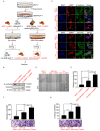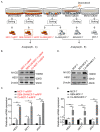The Interaction of the Senescent and Adjacent Breast Cancer Cells Promotes the Metastasis of Heterogeneous Breast Cancer Cells through Notch Signaling
- PMID: 33467780
- PMCID: PMC7830992
- DOI: 10.3390/ijms22020849
The Interaction of the Senescent and Adjacent Breast Cancer Cells Promotes the Metastasis of Heterogeneous Breast Cancer Cells through Notch Signaling
Abstract
Chemotherapy is one of the most common strategies for tumor treatment but often associated with post-therapy tumor recurrence. While chemotherapeutic drugs are known to induce tumor cell senescence, the roles and mechanisms of senescence in tumor recurrence remain unclear. In this study, we used doxorubicin to induce senescence in breast cancer cells, followed by culture of breast cancer cells with conditional media of senescent breast cancer cells (indirect co-culture) or directly with senescent breast cancer cells (direct co-culture). We showed that breast cancer cells underwent the epithelial-mesenchymal transition (EMT) to a greater extent and had stronger migration and invasion ability in the direct co-culture compared with that in the indirect co-culture model. Moreover, in the direct co-culture model, non-senescent breast cancer cells facilitated senescent breast cancer cells to escape and re-enter into the cell cycle. Meanwhile, senescent breast cancer cells regained tumor cell characteristics and underwent EMT after direct co-culture. We found that the Notch signaling was activated in both senescent and non-senescent breast cancer cells in the direct co-culture group. Notably, the EMT process of senescent and adjacent breast cancer cells was blocked upon inhibition of Notch signaling with N-[(3,5-difluorophenyl)acetyl]-l-alanyl-2-phenyl]glycine-1,1-dimethylethyl ester (DAPT) in the direct co-cultures. In addition, DAPT inhibited the lung metastasis of the co-cultured breast cancer cells in vivo. Collectively, data arising from this study suggest that both senescent and adjacent non-senescent breast cancer cells developed EMT through activating Notch signaling under conditions of intratumoral heterogeneity caused by chemotherapy, which infer the possibility that Notch inhibitors used in combination with chemotherapeutic agents may become an effective treatment strategy.
Keywords: EMT; Notch signaling; breast cancer cells senescence; co-culture system; doxorubicin.
Conflict of interest statement
The authors declare that they have no conflict of interest.
Figures





Similar articles
-
Inhibition of the Notch signaling pathway attenuates progression of cell motility, metastasis, and epithelial-to-mesenchymal transition-like phenomena induced by low concentrations of cisplatin in osteosarcoma.Eur J Pharmacol. 2021 May 15;899:174058. doi: 10.1016/j.ejphar.2021.174058. Epub 2021 Mar 21. Eur J Pharmacol. 2021. PMID: 33757752
-
3,6-dihydroxyflavone suppresses the epithelial-mesenchymal transition in breast cancer cells by inhibiting the Notch signaling pathway.Sci Rep. 2016 Jun 27;6:28858. doi: 10.1038/srep28858. Sci Rep. 2016. PMID: 27345219 Free PMC article.
-
Wenshen Zhuanggu formula mitigates breast cancer bone metastasis through the signaling crosstalk among the Jagged1/Notch, TGF-β and IL-6 signaling pathways.J Ethnopharmacol. 2019 Mar 25;232:145-154. doi: 10.1016/j.jep.2018.12.023. Epub 2018 Dec 18. J Ethnopharmacol. 2019. PMID: 30576770
-
Crosstalk between Notch, HIF-1α and GPER in Breast Cancer EMT.Int J Mol Sci. 2018 Jul 10;19(7):2011. doi: 10.3390/ijms19072011. Int J Mol Sci. 2018. PMID: 29996493 Free PMC article. Review.
-
Notch Signaling in Breast Cancer: A Role in Drug Resistance.Cells. 2020 Sep 29;9(10):2204. doi: 10.3390/cells9102204. Cells. 2020. PMID: 33003540 Free PMC article. Review.
Cited by
-
The role of Hedgehog and Notch signaling pathway in cancer.Mol Biomed. 2022 Dec 15;3(1):44. doi: 10.1186/s43556-022-00099-8. Mol Biomed. 2022. PMID: 36517618 Free PMC article. Review.
-
Tumor metastasis: Mechanistic insights and therapeutic interventions.MedComm (2020). 2021 Dec 2;2(4):587-617. doi: 10.1002/mco2.100. eCollection 2021 Dec. MedComm (2020). 2021. PMID: 34977870 Free PMC article. Review.
-
Systematic proteomics analysis revealed different expression of laminin interaction proteins in breast cancer: lower in luminal subtype and higher in claudin-low subtype.Transl Cancer Res. 2024 May 31;13(5):2108-2121. doi: 10.21037/tcr-23-2214. Epub 2024 May 29. Transl Cancer Res. 2024. PMID: 38881926 Free PMC article.
-
The Common Hallmarks and Interconnected Pathways of Aging, Circadian Rhythms, and Cancer: Implications for Therapeutic Strategies.Research (Wash D C). 2025 Mar 5;8:0612. doi: 10.34133/research.0612. eCollection 2025. Research (Wash D C). 2025. PMID: 40046513 Free PMC article. Review.
-
Near-Death Cells Cause Chemotherapy-Induced Metastasis via ATF4-Mediated NF-κB Signaling Activation.Adv Sci (Weinh). 2023 Apr;10(10):e2205835. doi: 10.1002/advs.202205835. Epub 2023 Feb 5. Adv Sci (Weinh). 2023. PMID: 36739602 Free PMC article.
References
-
- Stewart C.A., Gay C.M., Xi Y., Sivajothi S., Sivakamasundari V., Fujimoto J., Bolisetty M., Hartsfield P.M., Balasubramaniyan V., Chalishazar M.D., et al. Single-cell analyses reveal increased intratumoral heterogeneity after the onset of therapy resistance in small-cell lung cancer. Nat. Rev. Cancer. 2020;1:423–436. doi: 10.1038/s43018-019-0020-z. - DOI - PMC - PubMed
-
- Ljungkvist A.S.E., Bussink J., Rijken P.F.J.W., Kaanders J.H.A.M., Van Der Kogel A.J., Denekamp J. Vascular architecture, hypoxia, and proliferation in first-generation xenografts of human head-and-neck squamous cell carcinomas. Int. J. Radiat. Oncol. 2002;54:215–228. doi: 10.1016/S0360-3016(02)02938-3. - DOI - PubMed
MeSH terms
Substances
Grants and funding
LinkOut - more resources
Full Text Sources
Other Literature Sources
Medical

